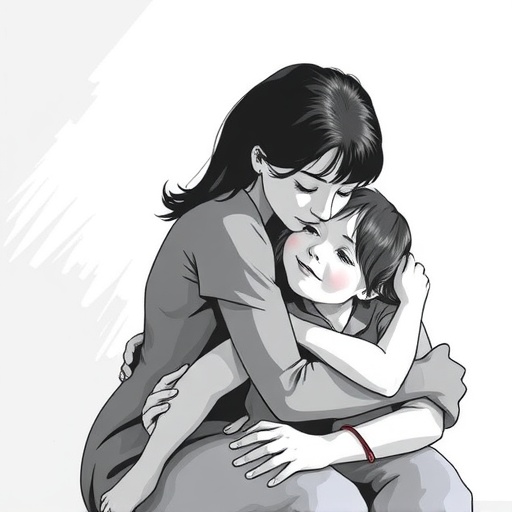In a groundbreaking shift from conventional wisdom, emerging research reveals a counterintuitive dynamic in familial mental health: it appears that children’s depressive symptoms may actually predispose or exacerbate maternal depression over time, challenging the long-held view that maternal depression primarily influences child outcomes. This provocative finding emerges from a detailed longitudinal study conducted during the COVID-19 pandemic, which scrutinized patterns of mental health interactions within mother-child dyads. While these insights are preliminary and require replication in varied post-pandemic contexts, they herald an urgent call for reimagined, family-centered psychiatric interventions that target both youth and caregivers concurrently.
Historically, clinical and epidemiological research has emphasized how maternal depression constitutes a critical risk factor for the development of depressive and anxiety disorders among offspring. The transmission of risk has been understood through multiple pathways, including genetic inheritance, in utero environmental influences, and psychosocial modeling of behavior. Such models informed preventative strategies aimed at alleviating parental psychopathology to indirectly shield children from adverse outcomes. However, the new findings challenge this unidirectional paradigm by illuminating a potentially reciprocal or even reverse causal flow wherein child depression may serve as a catalyst, rather than simply a consequence, of maternal depressive symptomatology.
The study utilized sophisticated longitudinal modeling techniques to track depressive symptoms in a cohort of mothers and their children across multiple time points during the stress-inducing conditions of the global pandemic. Leveraging standardized psychiatric assessment tools and validated self-report measures, researchers meticulously disentangled temporal precedence effects to ascertain the directionality of influence between maternal and child depression. The analytic approach accounted for confounding variables such as socioeconomic stressors, family structure, and pandemic-related disruptions, thereby enhancing the robustness and specificity of the observed associations.
One surprising but critical insight from the analysis is that as children exhibited worsening depressive symptoms—characterized by persistent sadness, anhedonia, and social withdrawal—mothers concurrently reported exacerbating depressive affect, fatigue, and reduced functional capacity. This pattern suggests a bidirectional feedback loop within families, where the emotional states of children and mothers are intricately intertwined, possibly mediated by increased caregiving burden, emotional contagion, and stress proliferation across family systems. This interplay underscores the complexity of psychiatric symptom transmission and warrants integrated assessments that consider the emotional health of all family members rather than isolating individuals.
From a mechanistic standpoint, the child-to-parent influence might manifest through various psychosocial stressors. Children struggling with depression often demonstrate increased dependency, impaired academic and social functioning, and behavioral challenges that can elevate caregiver strain. Such intensified caregiving demands could heighten maternal stress and diminish available psychological resources, thereby potentiating depressive symptom onset or worsening. Neurobiological hypotheses also speculate that chronic exposure to a depressed child’s emotional distress may dysregulate maternal hypothalamic-pituitary-adrenal axis activity, contributing to mood disorder pathogenesis.
These revelations bear profound implications for mental health policy and clinical practice. Current therapeutic models predominantly prioritize parental treatment with the secondary goal of improving child mental health outcomes. However, this evidence advocates for a paradigm shift toward holistic, family-centric approaches that simultaneously target the mental health needs of both children and mothers. Family therapy modalities, dyadic interventions, and systemic support services may truncate pathogenic feedback loops, enhancing overall effectiveness and sustainability of mental health recovery within households.
Furthermore, researchers emphasize the necessity of validating these findings beyond the extraordinary context of a global pandemic. COVID-19 precipitated unprecedented psychosocial stress, including social isolation, disruptions in educational and healthcare access, and economic instability, all of which plausibly intensified depressive symptom trajectories. Expanding this line of inquiry to non-pandemic cohorts and diverse cultural settings will be essential to discern baseline mechanisms from context-dependent phenomena. Such efforts will inform the calibration of prevention programs tailored to variable risk profiles.
Another aspect underscored by the study relates to the diagnostic and monitoring processes for depressive disorders in family contexts. Clinicians are encouraged to conduct comprehensive family mental health screenings that move beyond the patient’s symptoms to incorporate child and caregiver interactions and emotional climates. This holistic diagnostic stance may facilitate early identification of at-risk dyads and foster more nuanced clinical formulations and treatment plans, ultimately improving prognostic outcomes for both generations.
The study’s methodology exemplifies a growing emphasis on utilizing rigorous longitudinal data analytics in psychiatric epidemiology. By leveraging advanced statistical modeling, including cross-lagged panel analyses and hierarchical linear models, the research delineates complex symptom trajectories and directionalities that cross-sectional studies cannot capture. This methodological rigor enhances the veracity of conclusions drawn and sets a new standard for future family mental health research.
Given the pervasive impact of depressive disorders globally, the study’s emphasis on familial interconnections resonates with ongoing efforts to dismantle stigma and improve mental health literacy. Public health messaging and community-based interventions could benefit from incorporating these insights to promote awareness of the mutual influences within families, thereby encouraging early help-seeking behaviors and collective resilience-building strategies.
In conclusion, this pioneering research challenges entrenched assumptions about the directionality of depressive symptom transmission within families, spotlighting the significant role of child depression in shaping maternal mental health trajectories. Through intricate longitudinal analyses conducted amidst a global crisis, the study propels mental health discourse into a more integrative family-oriented framework. Continued exploration and expansion of this paradigm hold promise for more effective interventions that recognize and address the dynamic emotional interdependencies shaping mental health across generations.
Subject of Research: Maternal and child depression dynamics during the COVID-19 pandemic
Article Title: [Not specified in the provided content]
News Publication Date: [Not specified in the provided content]
Web References: [Not specified in the provided content]
References: (doi:10.1001/jamapediatrics.2025.2822)
Image Credits: [Not specified in the provided content]
Keywords: Depression, Mothers, Children, Adolescents, Medical tests, Pediatrics, Health care, Mental health, Family




